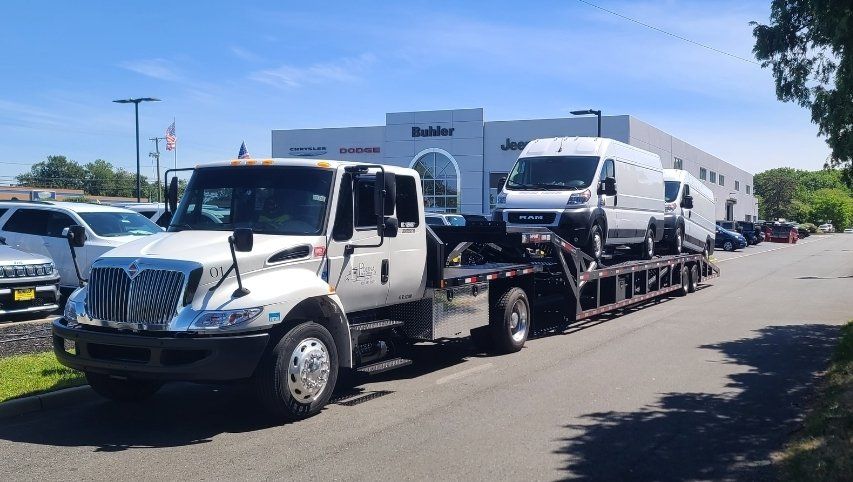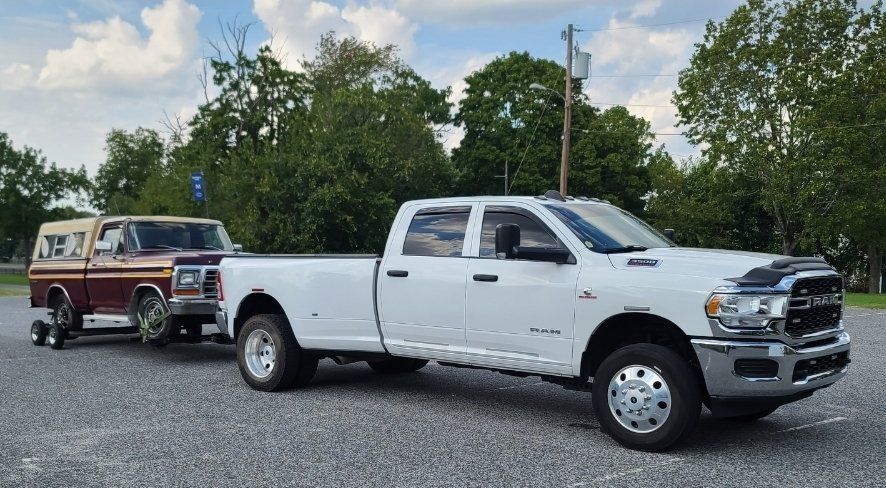Blog Layout
Vehicle Safety Checks: A Quick Guide for Drivers
jthrillz • January 27, 2025
Ensuring your vehicle is roadworthy doesn’t have to be a time-consuming process. Conducting quick safety checks before hitting the road can significantly enhance your driving safety and help prevent potential breakdowns or accidents. Here’s a step-by-step guide to the essential safety checks every driver should perform before starting their journey. For assistance, contact us at
908 357 0903 or visit our Instagram page at
Polina Transporter.
1. Inspect the Tires
Your tires are the only contact between your vehicle and the road, making their condition crucial. Start by checking the following:
• Tire Pressure: Use a tire pressure gauge to ensure the pressure matches the recommended levels in your vehicle’s manual. Underinflated or overinflated tires can affect handling and fuel efficiency.
• Tread Depth: Confirm that the tread depth is within the legal limit (typically 1.6 mm or more). Insert a tread depth gauge or use the penny test for a quick check.
• Visible Damage: Look for cuts, bulges, or punctures on the tire’s surface and sidewalls.
2. Check Lights and Indicators
Faulty lights can compromise visibility and communication with other drivers. Walk around the car and check:
• Headlights:
Test both low and high beams.
• Brake Lights:
Have someone press the brake pedal while you check the rear lights.
• Turn Signals and Hazards:
Activate all indicators and hazard lights to confirm functionality.
• Fog Lights:
Ensure they’re operational if your vehicle is equipped with them.
For expert advice, call
908 357 0903 or connect with us on Instagram:
Polina Transporter.
3. Assess Fluid Levels
Fluids are the lifeblood of your vehicle. Inspect the following:
• Engine Oil:
Use the dipstick to check the oil level and top up if necessary. Ensure the oil is clean and not excessively dirty.
• Coolant:
Check the coolant reservoir level and ensure it’s between the minimum and maximum markers.
• Brake Fluid:
Verify that the brake fluid level is sufficient and doesn’t appear discolored.
• Windshield Washer Fluid:
Top it up if it’s low, especially before a long journey or bad weather.
• Transmission Fluid:
If your vehicle has a dipstick for transmission fluid, ensure it’s at the proper level and appears clean.
4. Examine the Brakes
Brakes are critical for safety. Here’s how to check them:
• Listen for Unusual Noises:
Grinding or squeaking sounds while braking may indicate worn-out brake pads.
• Test Responsiveness:
Ensure the brake pedal feels firm and responsive.
• Check Brake Discs and Pads:
If visible through the wheels, inspect for excessive wear or unevenness.
5. Ensure Clear Visibility
Visibility is key to safe driving. Address these areas:
• Windshield and Windows:
Clean all glass surfaces and check for cracks or chips that may impair visibility.
• Wipers:
Test the windshield wipers and replace them if they leave streaks or squeak during use.
• Mirrors:
Adjust side and rearview mirrors to the correct position.
6. Test the Battery
A weak battery can leave you stranded. Check:
• Connections:
Ensure the terminals are securely attached and free from corrosion.
• Voltage: If you have a multimeter, test the battery voltage. A fully charged battery should read around 12.6 volts.
7. Inspect Belts and Hoses
Under the hood, examine the belts and hoses for:
• Cracks or Fraying:
Replace any worn-out belts immediately.
• Leaks or Bulges:
Ensure hoses are secure and free from leaks or swelling.
8. Look Underneath the Vehicle
A quick glance beneath your car can reveal issues such as:
• Fluid Leaks:
Look for any puddles of oil, coolant, or other fluids.
• Damage:
Check for any visible damage to the exhaust system or other components.
9. Carry Emergency Supplies
Even with proper checks, emergencies can occur. Ensure your car is stocked with essentials like:
• A first aid kit
• Jumper cables
• A flashlight with spare batteries
• A basic tool kit
• Reflective triangles or flares
• A spare tire, jack, and lug wrench
10. Plan for Seasonal Changes
Adjust your safety checks according to the season:
• Winter:
Check for adequate antifreeze levels and consider winter tires.
• Summer:
Inspect the air conditioning system and ensure tires are not overinflated due to heat.
Conclusion
Taking a few minutes to conduct these quick safety checks can save you from unexpected issues on the road. Make it a habit to perform these inspections regularly, especially before long trips or when driving in challenging weather conditions. Need help? Call us at 908 357 0903 or stay connected via Instagram at
Polina Transporter.
By prioritizing safety, you’ll enjoy peace of mind and a safer driving experience.

By Jitesh Malgire
•
January 6, 2025
Nothing is more inconvenient than being stranded on the side of the road and waiting for a tow truck. While Polina Transporter is always ready to provide fast and reliable towing services in NJ , we believe prevention is better than cure. Regular vehicle maintenance is the key to avoiding costly and stressful roadside emergencies. Here’s why staying on top of vehicle care can save you time, money, and hassle. 1. Avoid Sudden Breakdowns One of the main causes of emergency towing is unexpected vehicle breakdowns. These often result from neglected maintenance issues such as engine troubles, faulty batteries, or worn-out belts and hoses. Why It Matters: Routine checkups allow mechanics to catch potential problems before they become major issues, reducing the risk of sudden breakdowns. Tip: Schedule regular inspections and follow your vehicle’s maintenance schedule provided in the owner’s manual. 2. Extend the Life of Your Vehicle Every car has a lifespan, but how long it lasts depends heavily on how well it’s maintained. Ignoring routine maintenance can lead to accelerated wear and tear on critical components like the engine, transmission, and suspension system. Why It Matters: Proper care ensures your car stays in great shape for longer, reducing the likelihood of needing a tow due to severe damage. Tip: Regular oil changes, filter replacements, and fluid top-ups can make a big difference. 3. Improve Fuel Efficiency A poorly maintained vehicle often consumes more fuel, which not only impacts your wallet but also increases the likelihood of running out of gas unexpectedly. Why It Matters: Keeping your engine tuned and tires properly inflated improves fuel efficiency and prevents roadside emergencies like running out of fuel. Tip: Check your tire pressure monthly and refill fuel as soon as the tank hits the quarter mark. 4. Reduce Tire-Related Emergencies Flat tires and blowouts are among the most common reasons drivers call for roadside assistance. Many of these issues can be avoided with regular tire maintenance. Why It Matters: Proper tire pressure, alignment, and tread depth ensure your tires remain in good condition, reducing the risk of a sudden flat or blowout. Tip : Rotate your tires every 5,000-7,500 miles and replace them when the tread depth reaches 2/32 of an inch. 5. Ensure Battery Reliability A dead battery is one of the leading causes of roadside emergencies. Extreme temperatures, corrosion, and age can all affect battery performance. Why It Matters: Regular battery checks can prevent it from dying unexpectedly and leaving you stranded. Tip : Test your battery twice a year and replace it every 3-5 years, depending on its condition. 6. Prevent Overheating Issues An overheating engine can leave you stranded and in need of towing. This is often caused by low coolant levels, a faulty radiator, or a broken water pump. Why It Matters: Regular cooling system maintenance keeps your engine running at the right temperature and prevents costly breakdowns. Tip : Check your coolant levels regularly and flush the cooling system as recommended by your vehicle manufacturer. 7. Enhance Safety Neglecting maintenance can put your safety at risk. Failing brakes, worn-out wipers, or dim headlights can create dangerous situations on the road. Why It Matters: Proper maintenance ensures that all safety features of your car are functioning optimally, reducing the chances of accidents and emergencies. Tip : Replace brake pads as soon as you hear squeaking or grinding noises, and replace wiper blades every 6-12 months. 8. Save Money in the Long Run While maintenance might seem like an added expense, it’s far more affordable than the cost of emergency towing, repairs, or replacing major components. Why It Matters: Preventative care reduces the risk of expensive repairs and helps you avoid unnecessary stress during a roadside emergency. Tip : Think of maintenance as an investment in your vehicle’s longevity and reliability. Conclusion Regular vehicle maintenance is the cornerstone of safe, efficient, and worry-free driving. By staying proactive, you can avoid many of the common issues that lead to emergency towing. That said, emergencies can still happen despite your best efforts. When they do, you can count on Polina Transporter to provide fast and reliable towing services, emergency road assistance , and vehicle recovery across NJ. Save our number, (908) 357-0903 and drive with confidence knowing help is just a call away if you need it.

By jthrillz
•
December 6, 2024
When it comes to towing services, there are plenty of misconceptions floating around. Whether it’s about costs, reliability, or the overall process, these myths often prevent people from seeking help when they truly need it. At Polina Transporter , we believe in clearing the air so you can make informed decisions during roadside emergencies. Let’s debunk some of the most common myths about towing services.

